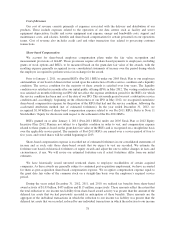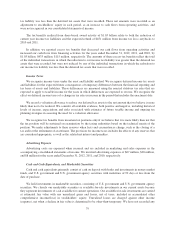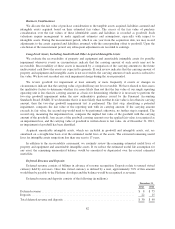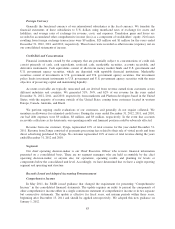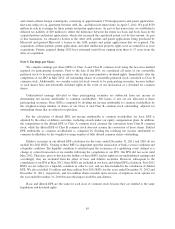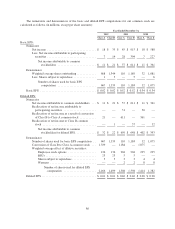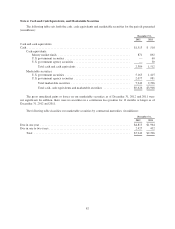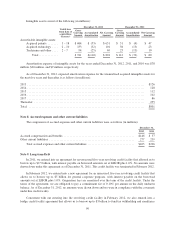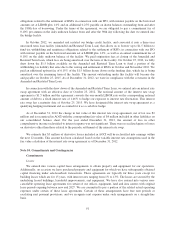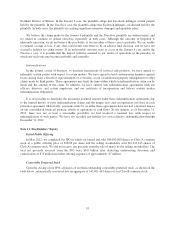Facebook 2012 Annual Report Download - page 89
Download and view the complete annual report
Please find page 89 of the 2012 Facebook annual report below. You can navigate through the pages in the report by either clicking on the pages listed below, or by using the keyword search tool below to find specific information within the annual report.and certain of their foreign counterparts, consisting of approximately 170 foreign patents and patent applications,
that were subject to an agreement between AOL Inc. and Microsoft entered into on April 5, 2012. We paid $550
million in cash in exchange for these patents and patent applications. As part of this transaction, we established a
deferred tax liability of $49 million to reflect the difference between the future tax basis and book basis in the
acquired patents and patent applications, which also increased the capitalized patent cost by this amount. As part
of this transaction, we obtained a license to the other AOL patents and patent applications being purchased by
Microsoft and granted Microsoft a license to the AOL patents and patent applications that we acquired. The
acquisitions of these patents, patent applications and other intellectual property rights were accounted for as asset
acquisitions. Patents acquired during 2012 have estimated useful lives ranging from three to 17 years from the
dates of acquisition.
Note 3. Earnings per Share
We compute earnings per share (EPS) of Class A and Class B common stock using the two-class method
required for participating securities. Prior to the date of the IPO, we considered all series of our convertible
preferred stock to be participating securities due to their non-cumulative dividend rights. Immediately after the
completion of our IPO in May 2012, all outstanding shares of convertible preferred stock converted to Class B
common stock. Additionally, we consider restricted stock awards to be participating securities, because holders
of such shares have non-forfeitable dividend rights in the event of our declaration of a dividend for common
shares.
Undistributed earnings allocated to these participating securities are subtracted from net income in
determining net income attributable to common stockholders. Net losses, if any are not allocated to these
participating securities. Basic EPS is computed by dividing net income attributable to common stockholders by
the weighted-average number of shares of our Class A and Class B common stock outstanding, adjusted for
outstanding shares that are subject to repurchase.
For the calculation of diluted EPS, net income attributable to common stockholders for basic EPS is
adjusted by the effect of dilutive securities, including awards under our equity compensation plans. In addition,
the computation of the diluted EPS of Class A common stock assumes the conversion from Class B common
stock, while the diluted EPS of Class B common stock does not assume the conversion of those shares. Diluted
EPS attributable to common stockholders is computed by dividing the resulting net income attributable to
common stockholders by the weighted-average number of fully diluted common shares outstanding.
Dilutive securities in our diluted EPS calculation for the years ended December 31, 2011 and 2010 do not
include Pre-2011 RSUs. Vesting of these RSUs is dependent upon the satisfaction of both a service condition and
a liquidity condition. The liquidity condition is satisfied upon the occurrence of a qualifying event, defined as a
change of control transaction or six months following the completion of our IPO. Our IPO did not occur until
May 2012. Therefore, prior to this date the holders of these RSUs had no rights in our undistributed earnings and
accordingly, they are excluded from the effect of basic and dilutive securities. However, subsequent to the
completion of our IPO in May 2012, these RSUs are included in our basic and diluted EPS calculation. Post-2011
RSUs are not subject to a liquidity condition in order to vest, and are thus included in the calculation of diluted
EPS. We also excluded 15 million and three million Post-2011 RSUs for the years ended December 31, 2012 and
December 31, 2011, respectively, and two million shares issuable upon exercise of employee stock options for
the year ended December 31, 2010 because the impact would be anti-dilutive.
Basic and diluted EPS are the same for each class of common stock because they are entitled to the same
liquidation and dividend rights.
85





